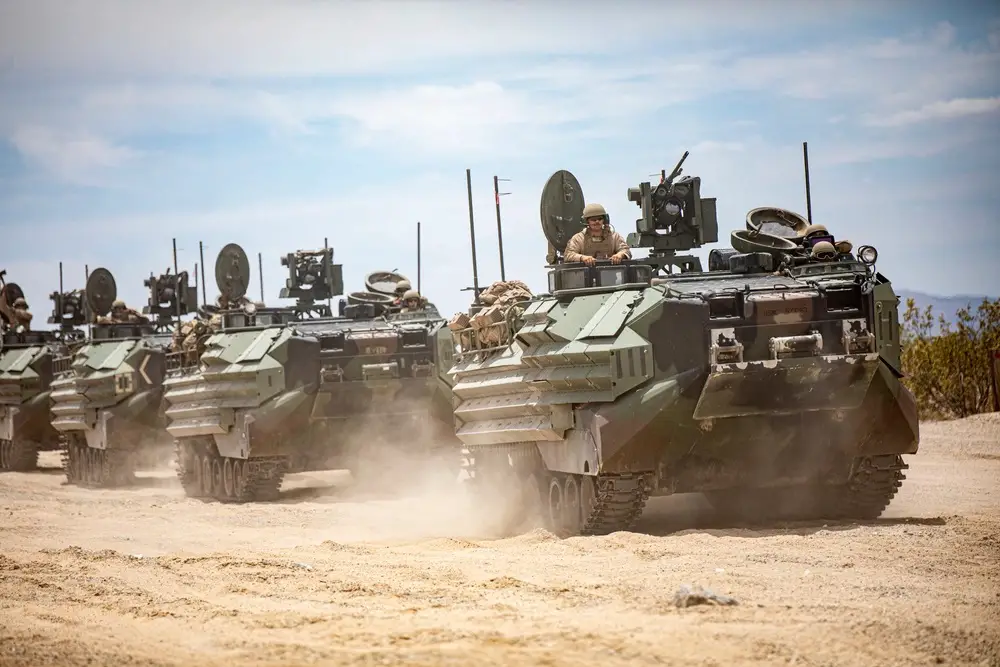The U.S. State Department has made a determination approving a possible Foreign Military Sale to the Government of Romania of sixteen (16) Assault Amphibious Vehicles (AAVs) and related equipment for an estimated cost of $120.5 million. The Government of Romania has requested to buy sixteen (16) Assault Amphibious Vehicles (AAVs), Personnel Variant (AAVP-7A1); three (3) Assault Amphibious Vehicles, Command Variant (AAVC-7Al); two (2) Assault Amphibious Vehicles, Recovery Variant (AAVR-7Al); sixteen (16) 50 Cal Machine Guns (Heavy Barrel); and five (5) 7.62 mm M240B Machine Guns. Also included are MK-19 Grenade Launchers; M36E T1 Thermal Sighting Systems (TSS); supply support (spare parts); support equipment (including special mission kits/Enhanced Applique Kits (EAAK)); training, unclassified technical manuals, technical data package, technical support (including Contractor Engineering Technical Services (CETS)); and other related elements of program and logistics support.

This proposed sale will support the foreign policy and national security objectives of the U.S. by helping to improve the security of a North Atlantic Treaty Organization (NATO) Ally which is an important force for political and economic stability in Europe. It is vital to the U.S. national interest to assist Romania in developing and maintaining a strong and ready self-defense capability. The proposed sale will improve Romania’s capability to meet current and future threats by modernizing and ensuring Romania’s continued expeditionary capability to counter regional threats. Romania will have no difficulty absorbing this equipment and services into its armed forces. A principal contractor has not been determined for potential sale. Implementation of this proposed sale will not require the assignment of U.S. Government personnel but will require the assignment of one (1) contractor representative to Romania for approximately one (1) year to deliver AAVs, equipment, and support.

The Assault Amphibious Vehicle (AAV)—official designation AAVP-7A1 (formerly known as Landing Vehicle, Tracked, Personnel-7 abbr. LVTP-7) is a fully tracked amphibious landing vehicle manufactured by U.S. Combat Systems (now BAE Systems). The AAV-P7/A1 is the current amphibious troop transport of the United States Marine Corps. It is used by U.S. Marine Corps Amphibious Assault Battalions to land the surface assault elements of the landing force and their equipment in a single lift from assault shipping during amphibious operations to inland objectives and to conduct mechanized operations and related combat support in subsequent mechanized operations ashore. It is also operated by other forces. Marines call them “amtracs”, a shortening of their original designation, “amphibious tractor”. In June 2018, the Marine Corps announced they had selected the BAE Systems/Iveco wheeled SuperAV for the Amphibious Combat Vehicle (ACV) program to supplement and ultimately replace the AAV.

AAVP-7A1 (Personnel) is the most common AAV, as it carries a turret equipped with an M2HB 12.7 mm (.50 caliber) heavy machine gun, and a Mk19 40 mm automatic grenade launcher. It carries four crew radios as well as the AN/VIC-2 intercom system. It is capable of carrying 21 combat equipped Marines in addition to the crew of 4: driver, crew chief/vehicle commander, gunner, and rear crewman. AAVC-7A1 (Command) only has two crew radios, and in addition to the VIC-2, it also carries two VRC-92s, a VRC-89, a PRC-103 UHF radio, a MRC-83 HF radio and the MSQ internetworking system used to control the various radios. This AAV has a crew of 3, and additionally carries 5 radio operators, 3 staff members, and 2 commanding officers. AAVR-7A1 (Recovery) is considered the “wrecker”, as it has a crane as well as most tools and equipment needed for field repairs. It is by far the heaviest of the three, and sits considerably lower in the water. Crew of three, plus the repairmen.

















